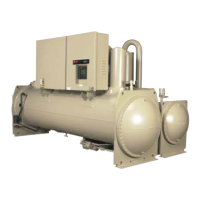RTHD-SVX01D-EN 139
Maintenance Procedures
6. If the level is below 2”, there is not enough oil in the sump. This can occur
from not enough oil in the system or more likely, oil migration to the evap-
orator. Oil migration can occur from a low refrigerant charge, gas pump
malfunction, etc.
NOTE: If the oil is logged in the evaporator confirm the operation of the gas
pump. If the gas pump is not functioning properly all oil will be logged in the
evaporator.
7. After the level is determined, close the service valves and remove the
hose/sightglass assembly.
Removing Compressor Oil
The oil in the compressor oil sump is under a constant positive pressure at
ambient temperature. To remove oil, open the service valve located on the
bottom of the oil sump and drain the oil into a suitable container using the
procedure outlined below:
CAUTION
POE Oil!
Due to the hygroscopic properties of the POE oil, all oil must be
stored in metal containers. The oil will absorb water if stored in a
plastic container.
Oil should not be removed until the refrigerant is isolated or removed.
8. Connect a line to the oil sump drain valve.
9. Open the valve and allow the desired amount of oil to flow into the con-
tainer and close the charging valve.
10. Measure the exact amount of oil removed from the unit.
Oil Charging Procedure
It is critical to fill the oil lines feeding the compressor when charging a system
with oil. The diagnostic “Loss of oil at the compressor stopped” will be gen-
erated if the oil lines are not full on start-up.
To properly charge the system with oil, follow the steps below:
1. Locate the 1/4” schrader valve between the ball valve and oil filter (or the
ball valve and oil cooler, if so equipped).
2. Loosely connect oil pump to schrader valve called out in step 1.
3. Operate oil charging pump until oil appears at the charging valve connec-
tion; then tighten the connection.
NOTE: Note: To keep air from entering the oil, the charging valve connection
must be air- tight.
4. Close the ball valve just upstream of the schrader valve connected to the
oil pump. This will allow the oil to travel through the oil lines to the com-
pressor first rather than directly to the oil sump.
5. Energize the master oil solenoid.

